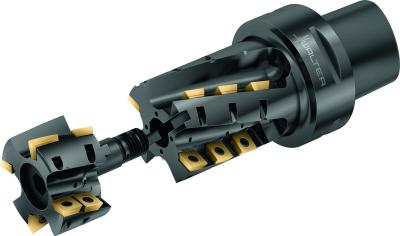
The M4258 modular helical milling cutter from Walter, the most recent addition to its M4000 family of high-performance helical milling cutters, brings cost efficiency and excellent process reliability to slot milling, and can be used for ramping, pocket milling, shoulder milling and circular interpolation as well. Versatility also extends to materials, handling ISO material groups P, M, K and S.
Tiger-tec Gold and Six Tiger-tec Silver grades are available, covering nearly all ISO groups. The modular design of the M4258 features an exchangeable front-end piece that can be replaced when this section of the body is worn or damaged. Precise and safe positioning of the front-end is assured due to its tongue and groove connection with the register pin. Features like this, combined with four/two cutting edges per insert, boost cost efficiency and reduce procurement and inventory costs and requirements.
Process reliability is enhanced by several features. Starting with a half-effective design and highly positive insert geometry, lower power requirements and costs that offer a strong advantage. An internal coolant supply in the standard offering adds versatility, along with superior chip removal. Operating under low cutting pressure, its compact length and effective design promotes smooth operation. This reduces oscillation and vibration, making it a solution for a variety of unstable machining conditions. The M4258 has an approach angle of 90° and a diameter range of 2.0, 2.5, and 3.0 in. (50, 63, and 80 mm). Interfaces are Walter Capto C6 and C8.
Contact Details
Related Glossary Terms
- approach angle
approach angle
Angle between the insert’s side-cutting edge and the line perpendicular to the milling cutter’s axis of rotation. Approach angle, which is also known as cutting edge angle, is used with metric units of measurement. See lead angle.
- coolant
coolant
Fluid that reduces temperature buildup at the tool/workpiece interface during machining. Normally takes the form of a liquid such as soluble or chemical mixtures (semisynthetic, synthetic) but can be pressurized air or other gas. Because of water’s ability to absorb great quantities of heat, it is widely used as a coolant and vehicle for various cutting compounds, with the water-to-compound ratio varying with the machining task. See cutting fluid; semisynthetic cutting fluid; soluble-oil cutting fluid; synthetic cutting fluid.
- gang cutting ( milling)
gang cutting ( milling)
Machining with several cutters mounted on a single arbor, generally for simultaneous cutting.
- interpolation
interpolation
Process of generating a sufficient number of positioning commands for the servomotors driving the machine tool so the path of the tool closely approximates the ideal path. See CNC, computer numerical control; NC, numerical control.
- materials handling
materials handling
Methods, equipment and systems for conveying materials to various machines and processing areas and for transferring finished parts to assembly, packaging and shipping areas.
- milling
milling
Machining operation in which metal or other material is removed by applying power to a rotating cutter. In vertical milling, the cutting tool is mounted vertically on the spindle. In horizontal milling, the cutting tool is mounted horizontally, either directly on the spindle or on an arbor. Horizontal milling is further broken down into conventional milling, where the cutter rotates opposite the direction of feed, or “up” into the workpiece; and climb milling, where the cutter rotates in the direction of feed, or “down” into the workpiece. Milling operations include plane or surface milling, endmilling, facemilling, angle milling, form milling and profiling.
- milling cutter
milling cutter
Loosely, any milling tool. Horizontal cutters take the form of plain milling cutters, plain spiral-tooth cutters, helical cutters, side-milling cutters, staggered-tooth side-milling cutters, facemilling cutters, angular cutters, double-angle cutters, convex and concave form-milling cutters, straddle-sprocket cutters, spur-gear cutters, corner-rounding cutters and slitting saws. Vertical cutters use shank-mounted cutting tools, including endmills, T-slot cutters, Woodruff keyseat cutters and dovetail cutters; these may also be used on horizontal mills. See milling.
- modular design ( modular construction)
modular design ( modular construction)
Manufacturing of a product in subassemblies that permits fast and simple replacement of defective assemblies and tailoring of the product for different purposes. See interchangeable parts.

